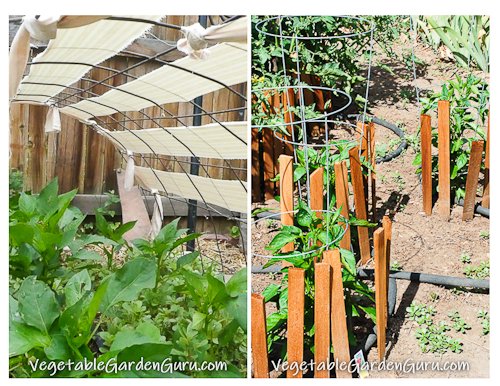| Back to Back Issues Page |
 |
|
Under the Arbor: June 2021 June 21, 2021 |
June 2021
Two Ways to Prevent Sunscald on Peppers
Two Ways to Prevent Sunscald on PeppersDon't you just hate it when your bell peppers finally start to develop, but then get those big mushy brown patches on them?I LOVE red peppers, but here at altitude in hot, dry Colorado my peppers would always get sunscald while still green. Peppers need sun, but not such intense and prolonged sun that the peppers cook before they're in the fajita pan! To prevent sunscald I now use moving, intermittent shade to cool things down. I'm not talking about some electric whirlygig invention, just a simple way to provide stripes of shade that move across the plant as the sun moves overhead, allowing the plant to cool off a little. Here are two ways:  On the Left:
I am a big fan of concrete reinforcing mesh: those 6'x10' panels available from Home Depot or contractor's supply places. (You can also buy a 50' or 100' roll.)
On the Left:
I am a big fan of concrete reinforcing mesh: those 6'x10' panels available from Home Depot or contractor's supply places. (You can also buy a 50' or 100' roll.)
I use it for making giant tomato cages and hoop tunnels that go over all my in-ground garden beds. When bent into an arch and covered with either plastic (greenhouse) or a bedsheet (hail protection), it is a multi-function wonder. You'll need a pair of bolt cutters to cut it, but you can easily bend it into the curve you want by standing on it, reaching over, and pulling it toward you in incremental steps. To make sunscald protection, I tore an old bedsheet into 3 or 4" strips, and wove the strips in and out of the mesh of my hoop tunnel. Voila! Intermittent moving shade that allows enough light for peppers to grow, but not to cook. On the Right:
Surround the south side of pepper (north if you're in the southern hemisphere) with wooden lath pushed into the ground.
As the sun moves, shade moves across the plant. Depending on how intense the sun and heat are where you live, you can place them with 2-4" spaces between them. And be sure they are tall enough.
Regenerative Agriculture in the Vegetable GardenRegenerative agriculture is a relatively recent term for some ancient ways of growing food, and it holds the promise of reversing all the negative effects that inadvertently came along with the Green Revolution, including climate change.While this may sound grandiose, as we are learn more and more about the soil ecosystem and how it works in nature, we're also discovering how much damage our modern industrial farming methods have caused to the soil. The loss of the soil ecosystem has driven massive amounts of carbon up into the atmosphere, causing it to trap heat. We're now learning how to regenerate the life in the soil, and thereby restore the soil's ability to hold carbon, minerals and water underground. The mycorrhizal fungi in an intact soil ecosystem literally carry mineral nutrition to plant roots from far away, and exchange it for sugars the plant has made. We can regenerate the soil's ability to grow food for humanity in this natural way, without costly agrochemical inputs that are driving many farmers out of business around the world. Regenerative agriculture's practices are easy to implement in the vegetable garden, using the same techniques used on regenerative farms. Here are regenerative agriculture's "tools": 1) No tilling or major soil disruption To read more about how to implement these practices in your own garden, click
here.
Happy Solstice! |
| Back to Back Issues Page |